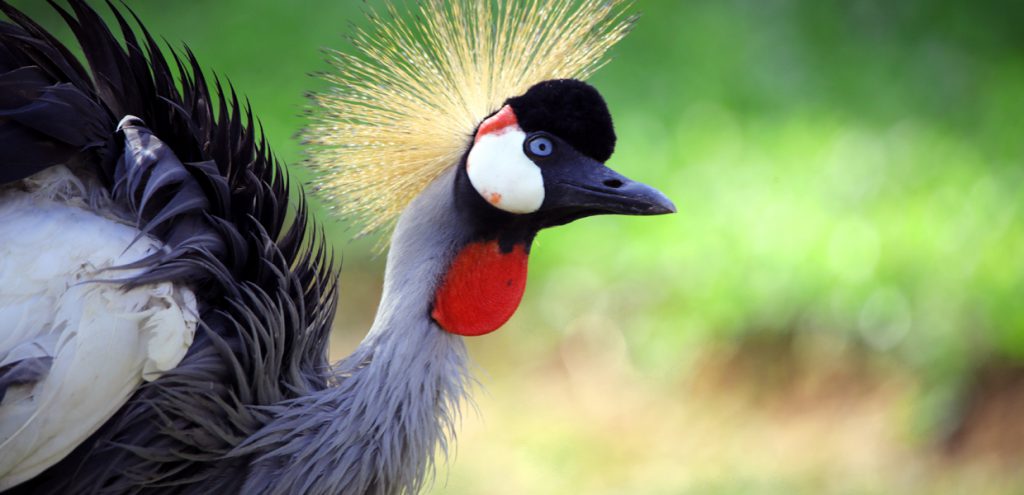Uganda is known for its beautiful landscapes and extraordinary wildlife species but little is said about its remarkable birding opportunities. Interestingly, this country, dubbed the Pearl of Africa is the quintessential birding safari destination of the East African region, boasting an incredible diversity of natural habitats that range from the Valleys, Lakes and Rivers, wetlands, Agricultural lands, savannah plains, woodlands, Rock outcrops, rainforests, to the mountain peaks
A total of 1080 bird species (60% of Africa’s total bird species and 11% of the World’s bird species) are found in the 241000-square kilometer Uganda.

Where can I watch birds in Uganda?
Murchison Falls National Park
At 3840 square kilometers, Murchison falls National Park is the largest Protected Area in Uganda but what few visitors know about it is that it is an excellent Birding destination with over 500 bird species. Its Riverine tickets are one of the top birding spots with sights and sounds of red-throated bee-eaters, swallow-tailed bee-eaters, malachite kingfishers, the double-toothed barbets, black-headed batis, giant Kingfishers, and Heuglin’s francolin, while the wetlands can be visited if you are interested in seeing the iconic shoebill storks.
Bigodi Wetland Sanctuary
Found within the 400-hectared Magombe Swamp fringing Kibale Forest National Park, Bigodi Wetland Sanctuary is also a fantastic birding destination with 200 bird species that include Crowned eagles, the Great blue Turaco, Black bee-eaters, papyrus canary, Yellow-rumped tinkerbird, snowy-crowned robin chats, papyrus gonolek, African pitta, Bocage’s bush shrike, Abyssinian ground thrush, Speckle-breasted woodpecker, Brown-chested Alethe, White-thighed hornbills, western nicator, to mention but a few.
Kibale Forest National Park
The 795-square-kilometer Kibale Forest National Park is not only the “Primate Capital of the World” and a wonderful “chimpanzee trekking destination in the country”, but also an unmissable birding safari destination with over 350 species.
While it is dominated by a tropical rainforest, there are other natural habitats that include wetlands, savannah grasslands, and agricultural lands along the borders. This Protected Area is home to the exceptional green-breasted pitta, Tropical boubou, the African pied wagtail, Great blue turaco, pin-tailed Whydah, Crowned eagles, Purple-breasted sunbirds, Slender-billed weavers, African grey parrots, Red-faced woodland warblers, Collared Apalis, white-naped pigeons, blue-headed bee-eaters, brown-chested alethe, Dusky crimsonwing, Kivu ground thrush, African fin foot, Spur-winged Goose, Black-capped Apalis, to mention but a few.
Semliki National Park
Semliki National Park is one of the remotest National Parks in Uganda with a size of 220 square kilometers that protect over 440 bird species in its wetlands, savannah grasslands, lowland forest, and riverine areas.
This Park is one of the homes to bird species endemic to the Guinea-Congo biome, the Lake Victoria Basin biome and Sudan-Guinea savannah biome among others. Here, the Red-throated Alethe, Black-casqued wattled hornbills, Spotted Greenbul, African openbill, Blue-shouldered Robin chat, Fore-crested Alethe, Nkulengu Rail, red-throated bee-eater, Northern bearded scrub-Robin, the Grey ground thrush, Malachite Kingfishers, lesser kestrel, Swamp palm Bulbul, Red-rumped tinkerbird, Blue swallows, White-tailed Robin-chat, Lowland Akalat, Yellow-throated Nicator, African Piculet, Fire-crested Alethe, Congo Serpent eagles, and many others are sheltered.
Bwindi Impenetrable National Park
This UNESCO World Heritage Site is not just a popular gorilla trekking destination but also a birding destination with about 350 bird species that include 23 Albertine Rift endemics. Bwindi as a wide range of natural habitats that include the dense rainforests, canopy contours, surrounding tea estates, and transitional areas that draw large numbers of birds that include Regal sunbirds, Archer’s ground robin, Black-faced Prinia, Neumann’s warblers, Cassin’s honeybird, handsome francolin, Rwenzori batis, strange weavers, Northern double-collared sunbirds, Jameson’s antpecker, Bronze-naped pigeon, Grey-chested iladopsis, to mention but a few.
One of the best birding spots in Bwindi Impenetrable National Park is Mubwindi Swamp within Ruhija sector where more than 50 species can be spotted in a single day.
Queen Elizabeth National Park
Uganda’s second largest National Park- Queen Elizabeth National Park has the highest ever-recorded number of bird species in a single destination at 600 species. It boasts varying natural habitats in form of sweeping vast savannah grasslands, wetlands, Lakes, forest and woodlands among others, Lots of Black-headed gonoleks, hammerkops, lesser black-backed gulls, and grey-crowned cranes can be spotted during birding tours between Mweya and Ishasha sector.
African shrikes, African skimmers, pied and giant kingfishers, great white pelicans, African fish eagles, pink-backed pelicans, African Jacana and shoebill storks are common during the 2-hour Kazinga Boat cruise.
Besides the mentioned places, Kidepo Valley National Park, Budongo Forest, Mount Elgon National Park, Echuya Forest Reserve, Mgahinga Gorilla National Park, Lake Mburo National Park, Mabamba Bay wetland, Kidepo Valley National Park, Lake Bisina, Nyamuriro Swamp, Nabugabo wetland, Rwenzori Mountains National Park and others are excellent birding destinations in Uganda.
What to pack for your birding tours in Uganda
preparation is fundamental in achieving unforgettable birding experiences in Uganda and having booked your plane tickets and made reservation for accommodation, the next thing is ticking your packing list which should include the right clothing (shirts and safari pants of neutral color), comfortable walking shoes/boots, a rain jacket, a waterproof daypack, a field guidebook, a camera with extra batteries and memory space, pair of binoculars, a water bottle, first aid kit a safari hat, and toiletries, to mention but a few.
When should I undertake a Birding Tour in Uganda?
Majority of the birds in Uganda are natives hence can be sighted throughout the year, but if you are interested in sighting the resident/migratory bird species, then your birding tour should be in November to April. Most travelers prefer the months of June to September because they are drier and brighter hence birding trails are less muddy and slippery.
